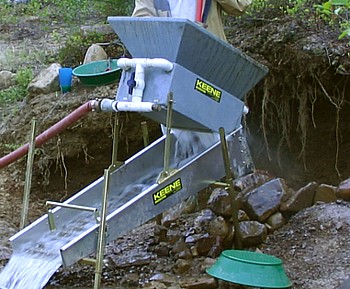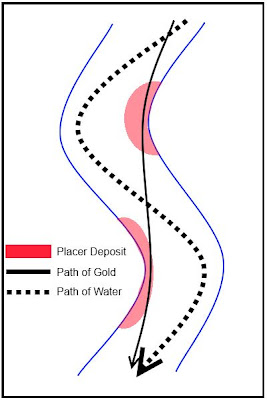There's not a lot of feedback on many products and there's certainly a lot of hype about others. I'm in no position to draw the line on what is good and what isn't simply because I haven't even seen all the products on the market with my own eyes. What i can do however is show you a list of whats available. Expect this list to grow and change in time.
Gold Panning and Prospecting Tools | Gold Pans!
its the #1 tool you can have. The funny thing about Gold pans is that you don't need an *actual* gold pan... you can use anything that holds water really. Some things work better than others. For instance an ice cream bucket will work a lot better than a rubber boot.Metal gold pans are all but a thing of the past now... a shame really because they had more than one purpose. The old timers use to cook their meals in them! Among other useful traits they didn't tend to float down the river if you dropped it by accident. Metal pans like to sink! It seems the new fangled plastic pans are taking over but its not so bad. They have some awesome features that make them better than their metal predecessors. Plastic gold pans have bigger and sharper riffles as well as new shapes that where never possible with metal.
To date You've definitely got your options when it comes to gold pans. Here's some pictures to give you an idea!
 I've personally used the Square pan made by LeTrap and find it to be a great tool for processing large amounts of material although it does lose small amounts of fine gold even with the proper technique. Other than that I'll stick to my generic round pan for sampling. Its mostly personal preference. I've also heard VERY good things about the Gold Rush Pro Gold Pan, and the Pyramid Pro Gold pan (bottom right and bottom left respectably) but have yet to try them.
I've personally used the Square pan made by LeTrap and find it to be a great tool for processing large amounts of material although it does lose small amounts of fine gold even with the proper technique. Other than that I'll stick to my generic round pan for sampling. Its mostly personal preference. I've also heard VERY good things about the Gold Rush Pro Gold Pan, and the Pyramid Pro Gold pan (bottom right and bottom left respectably) but have yet to try them.Next on the list of Gold panning equipment and tools:
Gold Panning & Prospecting Equipment | Sluice boxes
for the average small time gold panner and prospector sluice boxes are very important for moving large amounts of material quickly. Also known as River robbers, long toms, and a host of other names they rely on a current of water (usually placed in the stream) to wash material over their riffles and catch mats. The amount and velocity of the water are key factors in determining fine gold recovery. They don't come cheap but its not difficult to make your own. DIY jobs usually don't last too long in the field, are too heavy and generally just don't live up the expectations one might assume with a branded commercial sluice box. Below are some commonly available onesProline sluices. Available in a multitude of lengths and configurations.
Keene Engineering Sluices. Same thing, many sizes and configs:

LeTrap Plastic Sluices:

And even Home made!
As you can see they all have the basic principles at work. See now why the homemade ones can be heavy? They can be light too, but unless you're working with specialty plastics like the LeTrap or aluminum like the Keene and Proline it just wont be very durable. The LeTrap is a GREAT sluice box for beginner prospectors and gold panners. Its super lightweight, pretty reasonably priced and despite how it looks and what its made of, has been known to grab A LOT of fine gold along with the bigger stuff that almost no sluice misses. A lot of research has gone into the commercially available sluice boxes and you generally get what you pay for. Check out Wikipedia if you're still hungry for info regarding how these beauties work.
Lastly for today:
Gold Panning and Prospecting Tools | Highbankers!
High bankers fill that gap between "small time prospector and gold panner" to "small to medium production mining outfit" Also known as Power sluices, Highbankers let you do your sluicing anywhere that you want and there are recirculating systems available that allow for limitless set up locations because you won't need a steady fresh supply of water. They generally don't come with pumps which can get pricey depending on your highbanker's size and water needs. Most Prospectors don't invest in this equipment until they have found a claim with proven output. These tools are designed for high production and not necessarily for high mobility or ease of set up.Here's what they look like.



and last but definitely not least!

Its worth noting that the last image shown here with the LeTrap sluice can be set up quite cheaply and makes for a compact lightweight package. It can be even cheaper if your build the legs and stand yourself!! Every Gold Panner knows the best prospecting tool is a light prospecting tool!
That's enough for now.. next time I'll cover Dredges, Trommels, and Concentrate Clean up Equipment which should just about cover most of the prospecting tools and gold panning equipment.
![Reblog this post [with Zemanta]](http://img.zemanta.com/reblog_e.png?x-id=68a1239a-5ffb-496c-af90-797e166664f3)


![Reblog this post [with Zemanta]](http://img.zemanta.com/reblog_e.png?x-id=2eb7c41c-b596-4a00-b6f7-4eadeb6248b6)

![Reblog this post [with Zemanta]](http://img.zemanta.com/reblog_e.png?x-id=58c138c6-e0a1-4dff-a591-42cf0f6d1f76)


![Reblog this post [with Zemanta]](http://img.zemanta.com/reblog_e.png?x-id=956c7e6c-3ff4-4c7e-98d3-a2b935d04512)